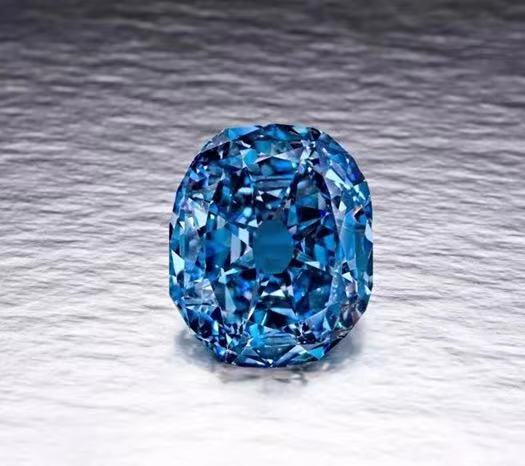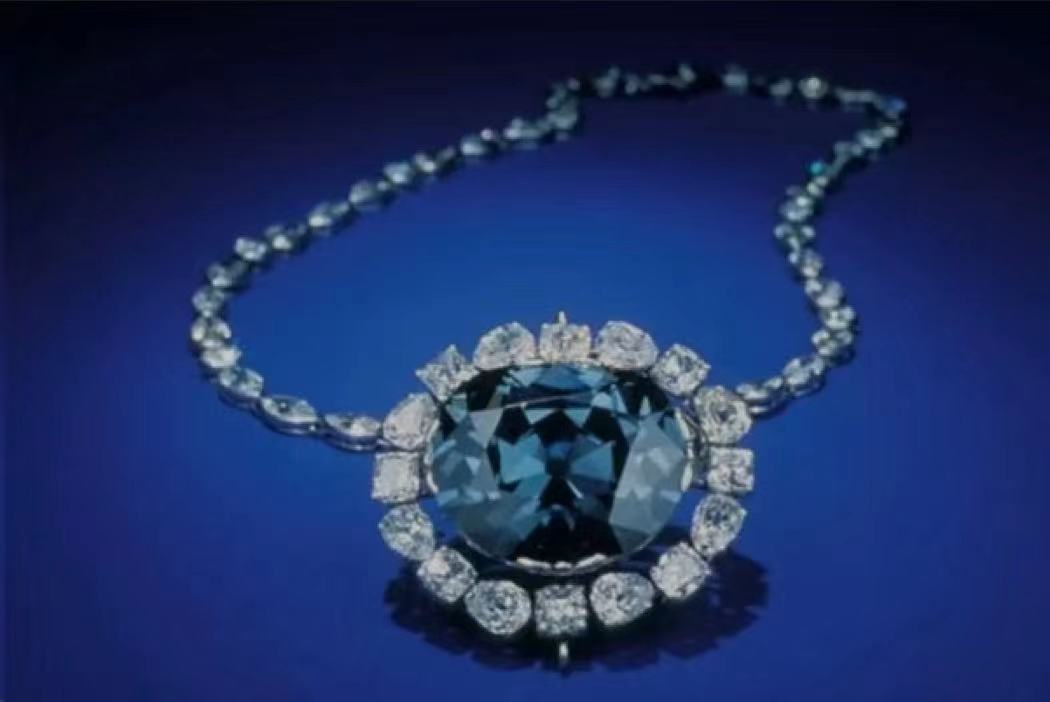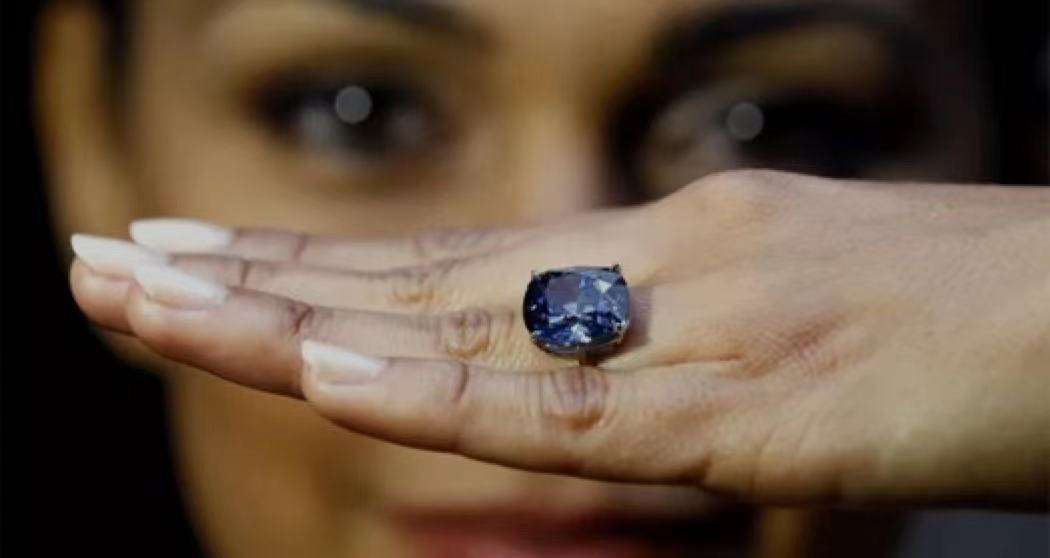Natural blue diamonds are the rare gems on earth after natural red diamonds. Over the years, the blue diamonds mined on the earth have weighed less than 600 carats. The top blue diamond is deep sea colour or blue sky colour, which is very attractive. Of course, just like the yellow diamonds and pink diamonds mentioned earlier, GIA also divides blue diamonds into several levels according to different tones. The higher the colour level of blue diamonds, the higher the value. Compared with other coloured diamonds, blue diamonds are the rarest rare diamonds.

Reasons for the formation of blue diamonds
Natural blue diamonds are typical IIb diamonds (in addition to scarcity and rarity, the origin of IIb diamonds has always been an unknown mystery in geology).
The blue diamond is blue for the following reasons:
The first one is caused by boron. Most blue diamonds are blue because boron (B) is mixed into the diamond during the formation process. The more boron, the thicker the blue colour. The boron atom has one less electron than the carbon atom, so when boron replaces carbon and enters the diamond lattice, it forms a hollow colour centre. The electrons of boron atoms produce an impurity energy level (boron receptor energy level) in the gap band. The energy interval between the boron receptor energy level and the diamond valence band (full band) is 0.4eV (with a large width, not always 0.4eV). As long as the electron absorbs 0.4eV energy (infrared light region), it jumps from the valence band (full band). Move to the boron receptor energy level. It absorbs red, yellow and green light in visible light with the naked eye, but does not absorb blue and purple light, so it presents a beautiful blue or blue-purple.
The second is natural radiation. Due to the formation of natural radiation colours I a and II a type blue diamond, it usually shows a variety of shades of green and blue.
The third hydrogen (H) atomic defect causes the colour. The natural blue diamond containing hydrogen (H) element is I, and its colour is gray-purple to blue-purple.
There are also mixed colours, generally blue diamonds with a strong gray tone.
Unlike all other coloured diamonds, blue diamonds contain the trace element "boron" in the formation process and have the characteristics of conductive power.
Origin of natural blue diamonds
The first natural blue diamond was found in the Gorconda mine in southern India. Pretoria and Cullinan mines in South Africa have become the main producing areas of high-quality blue diamonds. In addition, Australia's Argyle mine (sealed mine) is also a world-famous blue diamond production area, but the blue diamond produced by this mine usually contains light gray tones. Secondly, Indonesia's Borneo Island, Brazil, Guyana and Venezuela, where a small amount of blue diamonds are produced.
World-renowned blue diamond

Hope Diamond
The most famous blue diamond in the world is the "Dialmond of Hope". I hope the diamond is a boron-coloured blue diamond. Originally produced in India, this diamond weighed 112.25 carats after roughing, and was later given to King Louis XIV of France at that time.
It is famous all over the world not only because it is the largest and most perfect blue diamond that exists, but also because of its vicissitudes, the history of changes and the tragic colour of legend. The Star of Hope is full of mystery. This diamond has been passed down to this day. Except for its previous owner, Harry Wiston, the previous owner suffered bad luck after obtaining this diamond. Some died young, and some died in their career, so the Star of Hope is also known as the "Star of Doom".
Cultivate the blue colour in diamonds
Diamond cultivation is essentially a manual establishment of certain conditions to turn non-diamond structural carbon into diamond structural carbon. At present, the cultivation methods of diamond mainly include high temperature method and chemical vapour deposition method.
1. HPHT synthetic blue diamonds: The diamonds synthesised by this method are generally Ib yellow-brown diamonds. In order to synthesise blue diamonds, nitrogen absorbers and boron are added to the growth chamber. When nitrogen absorber is added, almost colourless type IIa diamond can be obtained, but this colourless diamond is very difficult to grow. Colourless diamonds grown with nitrogen absorbers can detect very few single nitrogen atoms, introduce boron, and remove most of the nitrogen with nitrogen absorbers, and the diamond can show a very bright blue.
The boron content of synthetic blue diamonds is very high, while the boron content of natural blue diamonds does not exceed 0.5 ppm (ppm is one millionth). The distribution of boron varies with the growth area. The octahedron growth area has the highest boron content, and the tetrahedron growth area has the lowest boron content. This leads to the uneven distribution of visible blue. In addition, when boron is added to the synthetic blue diamond, it will inevitably add single nitrogen, which will lead to the enhancement of absorption in the blue zone and the increase of transmission in the yellow-green zone, which may eventually lead to the green tone of synthetic blue diamond.
2. CVD synthetic blue diamond: It is a method of synthesising diamonds by decomposing carbon-containing gases under a low pressure equivalent to one-tenth of the atmospheric pressure. There are many ways to decompose carbon-containing gases into plasma, the most common of which is under high-temperature microwave. CVD synthetic blue diamonds also remove nitrogen from raw materials and equipment during the synthesis process, and then add boron to gradually reduce the absorption of blue light by red light, so as to obtain blue diamonds.

Blue diamond with later colour change
Later, some natural or artificially cultivated diamonds can also be processed into blue through discolouration, mainly high-temperature and high-pressure treatment and irradiation treatment:
1. High-temperature and high-pressure treatment of blue diamonds: provide sufficient isovalent pressure and potential energy for the lattice defects of brown, brown, yellow and other brown diamonds under high-temperature and high-pressure conditions in the laboratory. By artificially adjusting the temperature, pressure and medium conditions, it helps to improve the colour level or change the colour of the diamond.
For Ia brown, brown-yellow and brown diamonds, due to the presence of chromium impurity nitrogen atoms and vacancy in the crystal latice, it is almost impossible to significantly increase the colour level under the existing technical conditions. Therefore, on the basis of the existing plastic deformation of diamond, through high-temperature and high-pressure reprocessing, its plastic deformation strength is further loaded to promote the diffusion and slippage of dislocation in the crystal, so as to achieve the purpose of discolouration.
Type IIa brown, brown and brown diamonds overcome their obstacles and promote the dislocation in the diamond to climb, reorganise and annihilate under high temperature and high pressure conditions, so that it can be restored to the initial stable state before plastic deformation and restore its original colourless appearance to the maximum extent.
It is speculated that the high-temperature and high-pressure blue diamond is because the plastic defects inside the diamond disappear under high-temperature and high-pressure conditions, causing the gray to disappear and form a pure blue.
2. Irradiation treatment of blue diamonds: At present, the most commonly used methods of diamond irradiation are neutron irradiation and electronic irradiation. Neutron irradiation treatment mainly uses neutrons in nuclear reactors to bombard diamond. Because neutrons are not charged, it is easy to reach the range of nuclear force when colliding with diamond, which can cause nuclear reactions and easily change the overall colour of diamond. Electronic irradiation diamonds mainly accelerate the electronic bombardment of diamonds, causing a series of elastic or inelastic collisions to produce colour centres, and then selectively absorb a certain amount of visible light and finally colour them.
Type IIa diamond can knock out carbon atoms from the lattice by high-energy electron irradiation, creating a neutral hole, which is called GR1 colour centre. The zero phonon peak absorption peak of GR1 colour core is 740.9nm, and a wide absorption band accompanied by GR2~8 absorption peak is formed in the wavelength range of 430~412nm. The GR1 colour centre itself makes the diamond blue. When GR2~8 is strong, the diamond is blue-blue.
After Ia diamond irradiation, GR1 colour centre will also be produced, and it itself has N3 colour centre. N3 colour centre absorbs short-wave visible light, and GR1 colour centre absorbs long-wave visible light. The strength of the two colour centres determines whether the diamond is blue or green. Generally, irradiated blue diamonds have higher colour saturation than natural blue diamonds.
